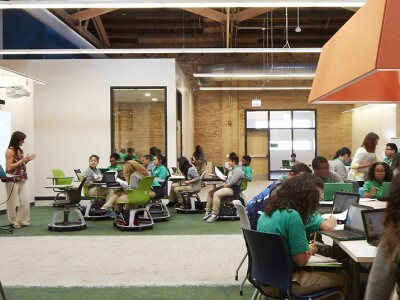3 Lessons from Transforming My Classroom
Topics

We’ve all had the experience of truly purposeful, authentic learning and know how valuable it is. Educators are taking the best of what we know about learning, student support, effective instruction, and interpersonal skill-building to completely reimagine schools so that students experience that kind of purposeful learning all day, every day.
From daily stress headaches to teaching that's once again manageable and enjoyable. Find out how this teacher turned around her professional practice with self-paced, mastery-based learning.
My head was pounding as I locked up my classroom for the day and headed out to my car. “I don’t know how I’m going to survive this year,” I said to myself.
Hands down, this had been the most stressful September in my 10 years of teaching high school ESOL for Fairfax County Public Schools. I had two English 9 ESOL Level 1 classes with about 10 students each, most of whom were from Central America and had arrived toward the end of the previous school year. I had just completed my Modern Classrooms Project (MCP) training a few weeks earlier, and I was eager to implement it. This program had given me an entirely new approach to teaching that is based on the blended learning concept; instead of moving the entire class along at one set pace, I would be prerecording lectures so students could complete lessons at their individual paces. This self-pacing structure, coupled with mastery-based grading, would allow me to spend more time checking in with students and giving one-on-one help instead of lecturing for half of each class period.
Initially, my Level 1 classes did very well with the MCP setup; my supervisor was excited to see students focused and collaborating so effortlessly. Then, I began to receive new students every day for the last two weeks of September. My small, smoothly running classes were now overcrowded and chaotic. As hard as I tried to maintain the flow of activities, it seemed impossible. At least three students at a time were waiting for help, and as students began to form new friendships with each other, they became more off-task.
By the end of the month, I was experiencing stress headaches almost every day. I had begun to question if teaching was still the right profession for me. Even so, I knew I owed it to both my students and my colleagues to press forward and find a way to make this year work. I wondered if the MCP model was the right way to go with these groups. Was this the best way to support my new students? Would choosing this model for their instruction empower them to develop more academic independence?
Even though I had my doubts, I decided to stay on the path I set and try any strategy to keep these classes going; I have seen new approaches to teaching pay off when given a fair chance before, and I truly felt that this one would be worth the effort. It has now been six months since the start of the year, and I am happy to say that these classes are now productive and manageable. My students have made visible progress with learning the class content and with working within the MCP model. As someone who turned around my own professional practice, here are the three most important lessons I learned along the way.
Was this the best way to support my new students? Would choosing this model for their instruction empower them to develop more academic independence?
Lesson 1: Set and Stick to a Routine
As is true within any class setting, maintaining a predictable and engaging routine is a fundamental key to success for both students and teachers alike. Testing a new approach to teaching can seem daunting to even the most seasoned educator, especially when it is something that has been largely unseen by others in the field. Although it took awhile to get the hang of it, my students embraced the new process for moving through lessons; many even began working harder to make more progress in a unit. The beauty of this structure for core lessons also means that teachers are free to include their own unique routines. For my Level 1 classes, I added a warm up routine that rotates based on the day of the week. Grammar practice is on Monday and Tuesday, short answer practice is on Wednesday and Thursday, and a journal entry and an online review game are on Friday. After the warm up, I post the MCP public progress tracker on the board so students can see where they left off in a unit and continue their lessons. Since classes at my school are 90 minutes long, students have ample time to complete their warm up, at least one lesson, and an exit ticket.
New students can learn and follow this routine very quickly, which is a huge advantage for classes like mine that can expect to receive new arrivals frequently throughout the year. Depending on where the class as a whole is paced, a teacher can decide how to tailor the unit to the needs of an individual student; this approach is helpful because it prevents new students from feeling overwhelmed when they begin.
Lesson 2: Adjust the Routine as Needed
As the class sizes, skill levels, and needs of students shift throughout a school year, the class routine needs to be tweaked and updated. The most airtight plans and strategies can be flipped around at any time in even the smoothest classroom; although the core structure of MCP is fairly set, it leaves room for educators to make adjustments as a year moves forward. This is a hugely helpful feature of the program which allows it to move and grow with students and teachers who use it. Below are some examples of the problems and solutions that can pop up in an MCP class during a school year.
- If class sizes drastically increase or decrease, a teacher may need to rethink and adjust the physical space of the classroom. Seating charts and desk locations may need to be changed, the flow of movement in a classroom may need to be altered, or group sizes may need to be changed.
- As students’ skill levels, lesson pacing, and motivation change throughout the year, a teacher may need to add or subtract to the routine as needed to meet student needs. This could be adding or subtracting the amount of lessons in any of the three designations (Must-Do, Should-Do, and Aspire to Do), adding or subtracting steps in a warm-up or closing routine, or adding additional motivation strategies (for example, adding an individual progress tracker in addition to a public tracker).
- As roster numbers and/or students’ abilities increase, teachers may find themselves stressed by their original routine. For example, they may not be able to grade mastery checks as quickly as before or may not be able to check in or conference with students without feeling rushed and overwhelmed. With the MCP structure, a teacher can adjust these details to better fit into their busy schedules and to adequately accommodate a class as it is, thus eliminating extra stress.
- As students become more self-directed learners, educators can shift control of learning into their hands. As students learn the routines and expectations of the class, teachers can increasingly create more opportunities for student collaboration, reflection, and self-determination, which will not only keep the class running smoothly, but help students become leaders of their own learning.
Students feel so proud when they see their progress in a tangible way.
Lesson 3: Celebrate Big and Small Gains
In even a normal school year, it can be very difficult to introduce a new way of teaching and running a class. Now more than ever, looking for and celebrating positive gains, academic and personal, can keep students and their teachers motivated. The pacing structure and lesson tracking components of the MCP model build in chances for teachers to celebrate their students and their progress, whether they complete one lesson in a week or three.
Students feel so proud when they see their progress in a tangible way; whether it’s seeing their name move forward on a public progress tracker or receiving stickers on an individual tracker, they will work to feel that accomplishment. Teachers can reinforce this motivation with big or little incentives, from something as exciting as prizes to anything as small but meaningful as saying, “Great job, I’m proud of you!” When a teacher believes in a student and encourages them to do their best, that student will continue to work hard. Just as importantly, teachers must also give themselves and students some room to make mistakes. No class can run perfectly every day, and no human can be their best self every day either. When students aren’t feeling well or are having a bad day, we can be compassionate and give them a break until they are ready to catch up. With patience and practice, students can achieve their goals without feeling pressured to be at their best at all times.
Changing my professional practice has not been an easy journey by any means. But following these three lessons has enabled me to create and maintain a productive, supportive environment for my students and for myself. Many of them have begun working more independently as both their familiarity with routines and their self-confidence have increased. Everyone has the freedom to work at their own pace, and I can support all students more closely and encourage them to keep moving forward. As students have settled into the class, I’ve slowly become less stressed and better able to support them every day; I have not had a headache in weeks, and I feel more confident that I am not only surviving this year but also beginning to thrive in my current role. Teaching Level 1 is a unique challenge, but MCP has made it more manageable and more enjoyable for me.
Photo at top courtesy of Wokandapix.




